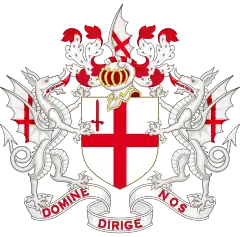| Ward of Portsoken | |
|---|---|
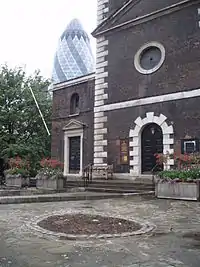 | |
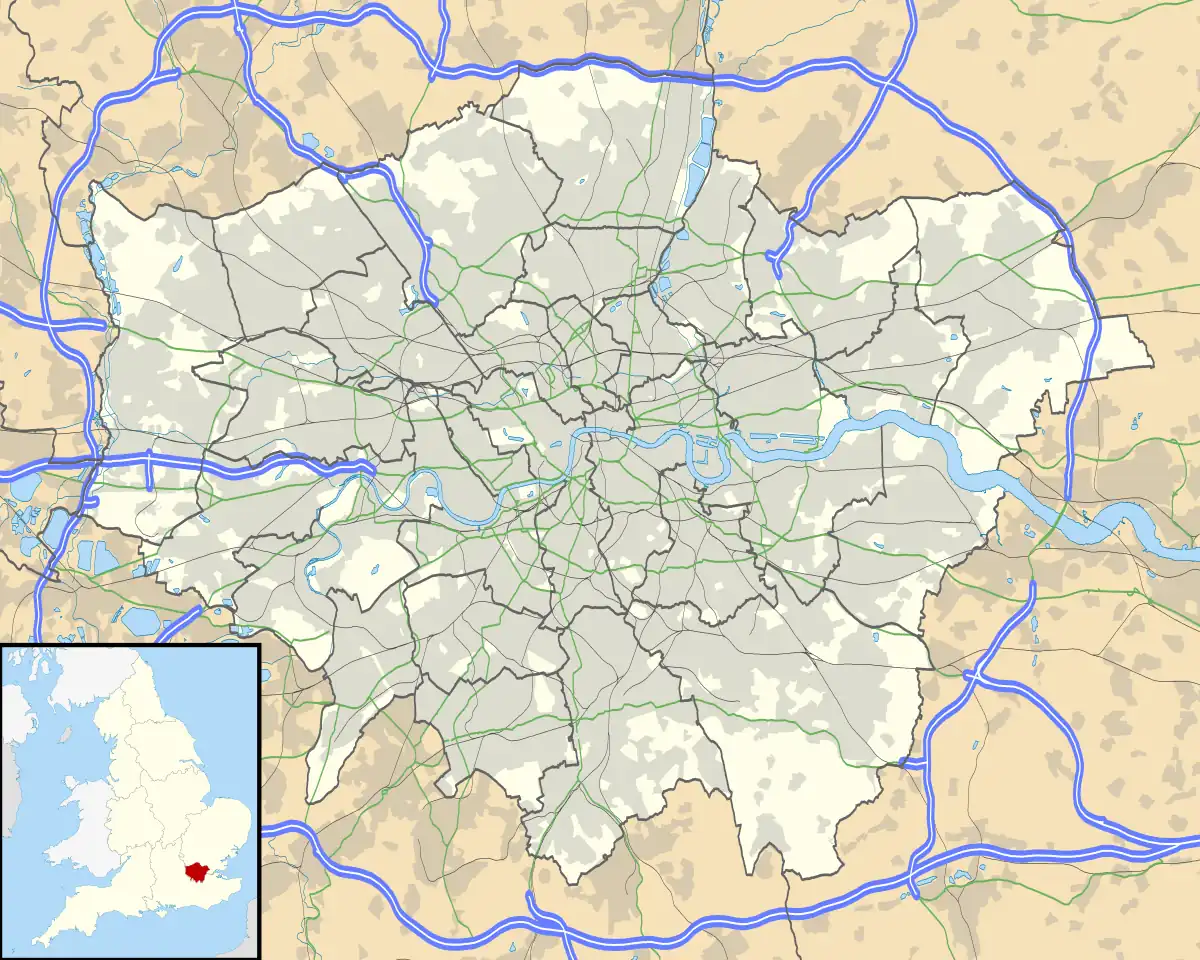 Ward of Portsoken Location within Greater London | |
| Population | 985 (2011 Census. Ward)[2] |
| Ceremonial county | Greater London |
| Region | |
| Country | England |
| Sovereign state | United Kingdom |
| Post town | LONDON |
| Postcode district | E1 |
| Postcode district | EC3 |
| Dialling code | 020 |
| Police | Metropolitan |
| Fire | London |
| Ambulance | London |
| UK Parliament | |
Portsoken, traditionally referred to with the definite article as the Portsoken,[3] is one of the City of London, England's 25 ancient wards, which are still used for local elections. Historically an extra-mural Ward, lying east of Aldgate and the City walls, the area is sometimes considered to be part of the East End of London.[4]
The ward is about 5 hectares in area, and is mainly oriented north-south, with the central part informally known as Aldgate.
History
John Stow's Survey of London records that the "soke" – in this context the right to extract fines as a source of income[5] – (later "liberty") was granted in the time of Saxon king Edgar the Peaceful, east of Aldgate to a guild of knights, the Cnichtengild, in exchange, essentially, for regular jousting. Norman kings confirmed these rights but later the land was voluntarily transferred to the Priory of the Holy Trinity by the descendants of the guild.
.jpg.webp)
In 1120 or 1121 (the exact date is unknown), the Portsoken was granted as a liberty to the Priory of Holy Trinity, which had been founded in 1107 by Queen Matilda, the wife of King Henry I. The sitting prior of Holy Trinity became, ex officio, an alderman of the City of London Corporation representing the Portsoken ward, and remained so until the Dissolution of the Monasteries by King Henry VIII in 1531.[6]
The Ward was originally coterminous with the once slightly larger parish of St Botolph without Aldgate and extended as far south as the Thames. However the growth of the Tower of London beyond the line of the London Wall, disputes with the Tower, the creation of the Tower Liberty other factors resulted in the southern area being lost to the ward and to the City of London, after around 1200.[7][8]
The area taken for the Tower Liberty was lost to both the City ward of Portsoken and to the parish, while East Smithfield was lost to the Portsoken but remained a apart of the parish. In 1442, St Katharine's (first established in 1147) became an independent Precinct, the Precinct of St Katharine by the Tower and so ceased to be a part of the East Smithfield area of the parish.
People
In 1332, a tax assessment showed 23 taxpayers in the Portsoken. However, this figure only included freemen of the City of London who possessed moveable property worth more than 10 shillings, and so did not include the poor, non-citizens, or members of religious orders.[9] A later subsidy roll from 1582 showed that the ward's taxpayers had been assessed to pay a total of 57 pounds, 11 shillings and 4 pence.[10]
The Portsoken has long had a mixed population, and in 1483 is recorded as having more aliens in its population than any ward in the City of London.[11]
This pattern of diversity continued, during the late 16th and early 17th centuries the parish of St Botolph without Aldgate as a whole (both the Portsoken and East Smithfield parts) is recorded as having a population of at least 25 people identified as "blackamoors."[12][13]
They appear to have arrived as a result of the war with Spain, being freed from Spanish slave ships, or slavery in Spanish colonies, by English warships. These free black Londoners, some of whom had mixed African and Spanish ancestry, often found work as sailors or interpreters. Many were servants and one appears to have worked at the Whitechapel Bell Foundry. The parish records from that time also reveal the presence of French, Dutch and Indian residents as well as at least one Persian and one East Indian (Bengali).[14][13]
Since the 1840s, nearly all of the Aldermen of the Ward have been Jewish.[15]
Boundary Changes
Boundary changes in 1994 and 2013 made often fundamental changes to the ancient Wards.[16] The Portsoken (part of the City of London) and the neighbouring London Borough of Tower Hamlets exchanged territory, with the Middlesex Street Estate being transferred to the Portsoken.[17]
Land was also exchanged with the Aldgate Ward (Aldgate was formerly entirely within the wall, with the Portsoken entirely without), so that John Cass's Foundation Primary School (now The Aldgate School) is now part of the ward, despite lying just inside the line of the wall.
The Portsoken is now regarded as one of the City's four residential wards, with a population of 985 (2011).[18]
Politics
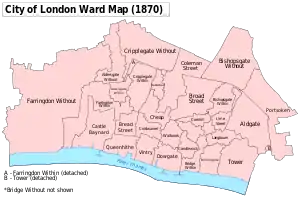
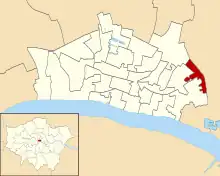
Portsoken is one of 25 wards in the City of London, each electing an alderman to the Court of Aldermen, and commoners (the City equivalent of a councillor) to the Court of Common Council of the City of London Corporation. Only electors who are Freemen of the City are eligible to stand for election.
Keith Joseph, Secretary of State for Industry 1979–1981 and Secretary of State for Education and Science 1981–1986, took the area as his territorial designation on elevation to the Lords in 1987. Similarly, Peter Levene (Lord Mayor 1998–1999) in 1997. Joseph's father was Lord Mayor in 1942–1943.
In 2014 William Campbell-Taylor made history when he became the first ever party politician to win a seat on the City of London's Common Council, standing as a Labour candidate in a by-election in the ward of Portsoken.[19] William Campbell-Taylor stood down as a Common Councilman in March 2017 at the end of his time in office.[20]
In the 2017 City-wide Common Council elections, the Labour Party won two seats in Portsoken ward with local residents Jason Pritchard and Munsur Ali topping the polls and Independent incumbents John Fletcher and Henry Jones elected in third and fourth place respectively.[21] The Labour Party won a record total of five seats on the Common Council in March 2017, winning two seats in Portsoken, two seats in Cripplegate ward and one seat in Aldersgate ward.[22]
In December 2017, William Campbell-Taylor stood as the first ever party political candidate to contest a City of London Aldermanic election, standing for Labour in Portsoken ward, but was defeated by Independent candidate Prem Goyal.[23][24] Prem Goyal is the founder of the UK political party, All People's Party,[25] although to date Goyal has chosen to stand as an Independent in elections in the City of London.[26]
City of London Corporation election, 2022
On 23 March 2022, the quadrennial Citywide Common Council Elections were held across the City of London. The election that took place in Portsoken Ward recorded the highest turnout in the entire 2022 Common Council Elections with 57.6% of the electorate casting their vote. The average turnout across the rest of the City of London was much lower at 36.5%. Two incumbent councillors, Munsur Ali and Jason Paul Pritchard, who were elected as Labour candidates in 2017, stood jointly and were both re-elected.[27] John Fletcher and Henry Jones stood jointly and were both re-elected.[28] Changes in voteshare are by party for the Labour candidates and by candidate for independent candidates who previously stood as independents.
| Party | Candidate | Votes | % | ±% | |
|---|---|---|---|---|---|
| Independent | John Fletcher* | 255 | 21.8 | ||
| No description | Munsur Ali* | 254 | 21.7 | N/A | |
| No description | Jason Paul Pritchard* | 239 | 20.5 | N/A | |
| Independent | Henry Jones* | 213 | 18.2 | ||
| Labour | Lana Joyce | 114 | 9.8 | ||
| Labour | Dominic Hauschild | 56 | 4.8 | ||
| Women's Equality | Alison Smith | 37 | 3.2 | N/A | |
| Turnout | 1,168 | 57.6 | |||
| Independent hold | |||||
| No description gain from Labour | Swing | – | |||
| No description gain from Labour | Swing | – | |||
| Independent hold | |||||
See also
References
- ↑ If you look carefully you can see the Portsoken Bulletin, detailing the ward officers.
- ↑ "City of London Ward population 2011". Neighbourhood Statistics. Office for National Statistics. Retrieved 16 October 2016.
- ↑ for instance, passim throughout "London 800-1216", by Brooke and Keir
- ↑ Guide to tours of the Jewish East End published by LBTH, 2003, https://www.towerhamlets.gov.uk/Documents/Leisure-and-culture/Tourism/Visitor-information/Jewish-East-End-walk-leaflet.pdf
- ↑ Citadel of the Saxons, by Rory Naismith, p. 163.
- ↑ p45, Inwood, Stephen, A History of London (Macmillan, 1998), ISBN 0-333-67154-6
- ↑ Haslam, Jeremy (1988). "Parishes, churches, wards and gates in Eastern London". In Blair, John (ed.). Minsters and Parish Churches: the local church in transition, 950–1200 (PDF). Oxford: University of Oxford Committee for Archaeology. pp. 35–43.
- ↑ "London, 800-1216". Brooke and Keir, Chapter 7
- ↑ p61, Inwood, Stephen, A History of London (Macmillan, 1998), ISBN 0-333-67154-6
- ↑ 1582 London Subsidy Rolls, British History Online
- ↑ Margins and marginality in 15th century London https://core.ac.uk/reader/190363108 Charlotte Berry
- ↑ Wood, Michael (2003). In Search of Shakespeare. BBC. ISBN 9780563534778.
- 1 2 "Britain's first black community in Elizabethan London". BBC News. 19 July 2012. Retrieved 26 October 2023.
- ↑ Nicholl, Charles (2008). The Lodger: Shakespeare on Silver Street. Penguin Books Limited. ISBN 9780141911878.
fashionable novelty
- ↑ LBTH doc on the Jewish EE, inc the Portsoken. https://www.ideastore.co.uk/assets/documents/Local%20History%20Archives%20Online/walks/Jewish_History_Walk_Final_Version.pdf
- ↑ The City and London Borough Boundaries Order 1993 (enacted 1994)
- ↑ Corporation of London, https://www.cityoflondon.gov.uk/services/housing/housing-estates/Pages/middlesex-street.aspx
- ↑ "Local statistics - Office for National Statistics". www.ons.gov.uk.
- ↑ First ever party politician to win a seat on the City of London's Common Council
- ↑ peterkenyon, Author (10 March 2017). "Saying thank you and sending best wishes to Rev Dr William Campbell Taylor".
{{cite web}}:|first=has generic name (help) - ↑ "Archived copy" (PDF). Archived from the original (PDF) on 9 November 2017. Retrieved 8 November 2017.
{{cite web}}: CS1 maint: archived copy as title (link) - ↑ "Labour wins record five seats in historic City of London election victory". Independent.co.uk. 24 March 2017.
- ↑ labourportsoken, Author (29 November 2017). "Labour's candidate William Campbell-Taylor on why party politics has a place in the City".
{{cite web}}:|first=has generic name (help) - ↑ Prem Goyal wins Portsoken Aldermanic election
- ↑ Goyal, Prem. "All People's Party – gathering momentum in Southwark". www.obv.org.uk. Operation Black Vote. Retrieved 12 December 2017.
- ↑ "Election results - City of London". mobile.cityoflondon.gov.uk. City of London Corporation. Retrieved 21 December 2017.
- ↑ "Your chance to shape the City's future City of London Corporation Elections 2022". www.speakforthecity.com. Retrieved 16 March 2022.
- ↑ "Your chance to shape the City's future City of London Corporation Elections 2022". www.speakforthecity.com. Retrieved 16 March 2022.
External links
- Map of Portsoken ward City of London Corporation (2003–)
- Map of Early Modern London: Portsoken Ward - Historical Map and Encyclopedia of Shakespeare's London
